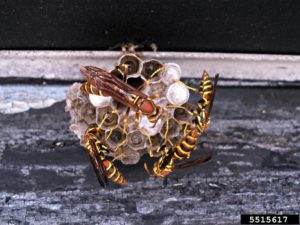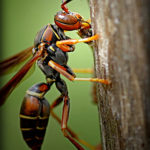General Information

Northern paper wasp nest.
Paper wasps are social insects, living in colonies of dozens of workers. Like other social wasps, paper wasps vigorously defend their nest against threats such as people who get too close to the nest entrance. Guard wasps stationed near nest entrances use chemical communication to warn the colony of intruders. Wasps can quickly emerge from a nest and attack people or animals that venture too close. Some individuals may have an allergic reaction to wasp stings, including anaphylactic shock.
Paper wasps are either scavengers or predators on other insects. Some species commonly scavenge for sweets and protein-rich foods in and around garbage cans and picnic areas, especially in the fall. In most parts of the country, paper wasp colonies die out each winter shortly after the first frost. Queen paper wasps survive the winter in sheltered locations like buildings or outdoors under bark, stones, loose leaves, or other shelter.
The objective of a paper wasp management program is to reduce human encounters with the wasps, but not to eliminate them from the entire area, since they are beneficial predators of insects. The two most productive and least environmentally destructive ways to do this are to modify the habitat to reduce access to food in the vicinity of human activities and to use physical controls such as nest removal.
Identification

Northern paper wasp Polistes fuscatus
Paper wasps are about 1/2 inch to ¾ inch long. Most species are black or red with distinct red, brown, and/or yellow markings. The European paper wasp, with its black and yellow markings, is often mistaken for a yellowjacket. Compared to honeybees, paper wasps are sparsely haired. They have a narrow petiole (“waist”) and long, slender legs that dangle in flight. Their wings are folded lengthwise, similar to yellowjackets and hornets. Their flight is slow compared to yellowjackets.
Paper wasp nests consist of a single layer of cells not enclosed within a paper sheath. Nests tend to be located in protected sites such as under eaves, exterior corners of windows, vent louvers, beneath decks, and uncapped fence poles. Chain link fence protectors are another potential nest site.
Suggested Thresholds
Remove nests in locations where they pose a threat to humans, on buildings, or in playgrounds. Because wasps are predators on other insects, it is not necessary to remove nests in remote locations.
Monitoring and Inspection
Beginning in the spring when queen wasps initiate nests, search probable nest locations. Check areas where nests have been built in the previous year. Knock down start-up nests with a pole or stream of water. Since only the queen is present, the stinging risk is much lower than later in the season when large numbers of workers are present.
Doing inspections and nest removal twice a month through July will greatly reduce the number of large nests present when school opens in August or September.
Non-chemical Control Measures
Sanitation/Cultural Control Measures
- Close the lids of garbage cans, recycle bins, and dumpsters. If possible, use bins with a self-closing lid. Bees and wasps, like children, are attracted to sweets such as soda cans or fruit scraps. Change bin and can liners often and clean them with soap and water regularly.
- Cover foods outdoors.
- Use wasp traps when events are scheduled outside to deter wasps from visiting people.
Physical/Mechanical Control Measures
- Remove the small nests in early spring. Control nests early before they get large.
- Remove nests located in areas frequented by people.
- Thoroughly clean the area where the nest was attached to decrease the likelihood that another nest will be built in that spot and to prevent other insects from eating the wasp remains. It is not necessary to remove remote nests that do not pose a threat of being stung.
Chemical Control Measures
Several general-use pesticides are available. These “wasp sprays” deliver the pesticide in a stream up to 20 feet long, allowing the applicator to keep a safe distance away from the nest. Apply sprays at night when the majority of the colony is in the nest. Using pesticides on individual workers is not an effective control measure.
Evaluation Methods
Conduct an inspection around the building periodically, ideally two times a month from May through September, in most areas of the country.
